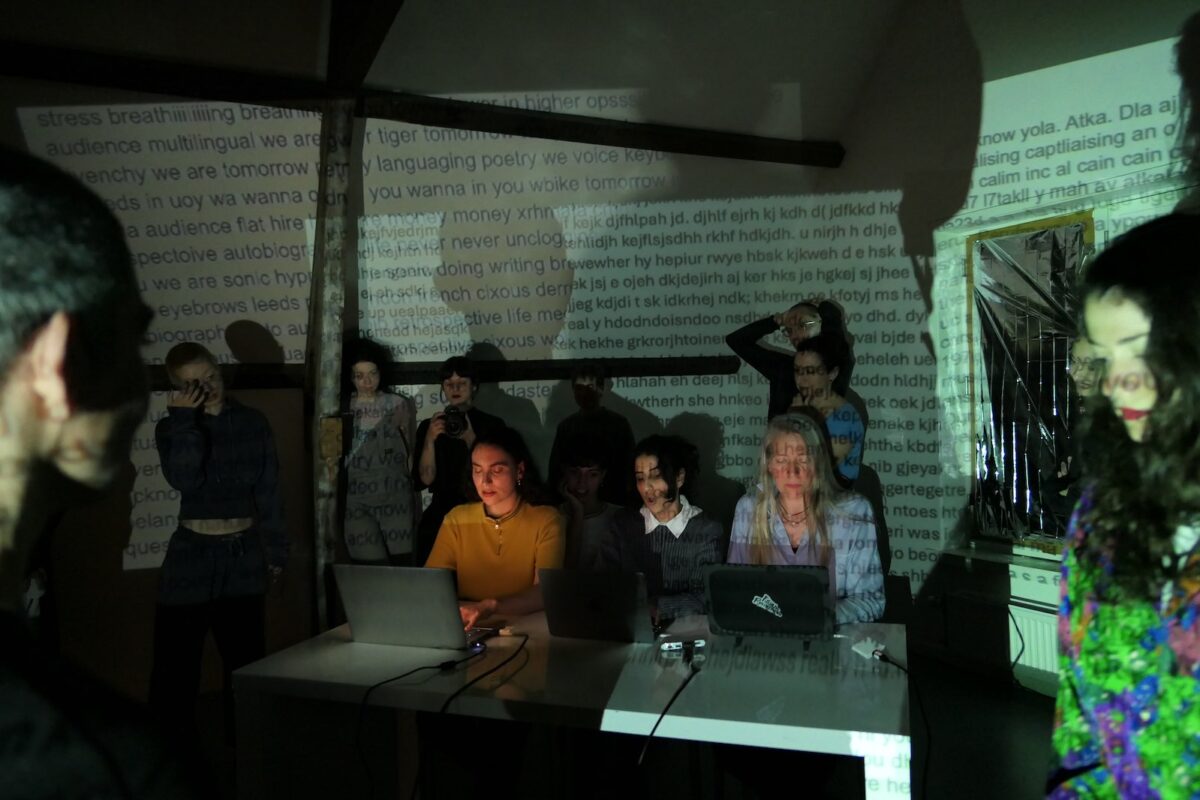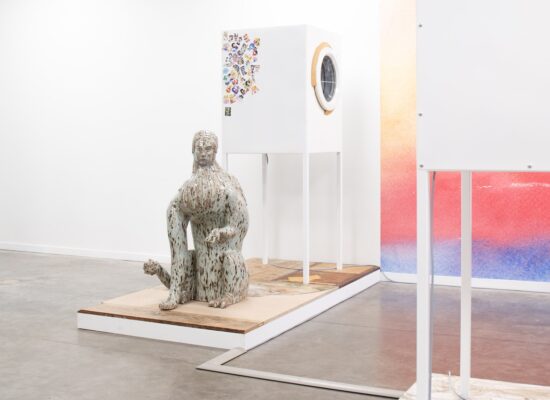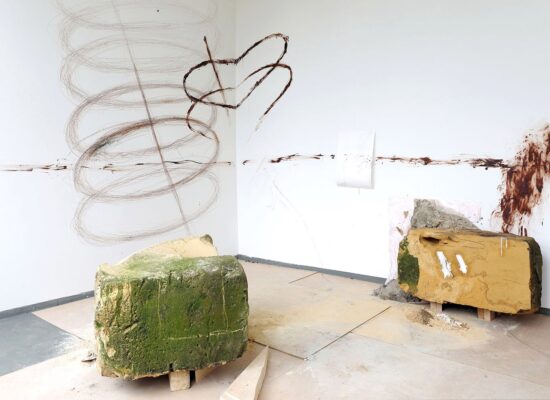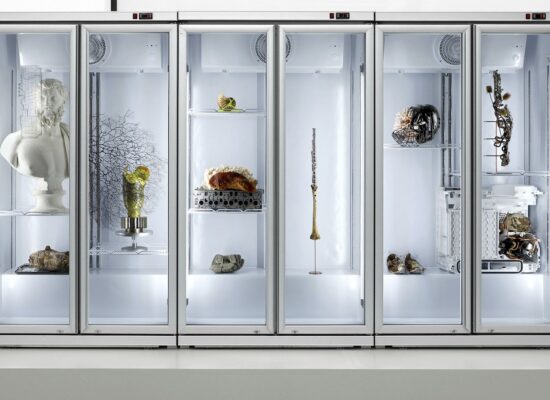How do you describe your own art practice?
My work is primarily language-based, unfolding across performance, video, radio, writing, and, more recently, installations. I approach language as a confined space and develop artistic methods that map its boundaries and create openings for moving beyond them.
Over the past few years, my research has focused on a practice I call nonstop languaging. Rooted in autotheory, nonstop languaging entails performing streams of consciousness by tracing my thoughts through language simultaneously in spoken and written form. I perform autotheory by merging ways of articulating autobiography—carrying the self in language—with ways of forming and digesting theory. The result is an overload of words: repeated, memorized, fragmented, or invented, all seeking their own linearity.
I have performed nonstop languaging in various contexts, both solo and in collaboration with other artists, as a 45-minute black box performance, a 4-hour durational performance streamed from my living room, a biweekly radio performance, a performance lecture during an artistic research conference, an ongoing performance at an art fair, and as part of my process for writing an academic article—always centering on the ephemeral encounter between performer and spectator.
In my new work, LANG U AGE I SAC ON FINED SPACE, I translate this research into an object-based installation. I isolate the keyboard—an essential element of my performance setup—and transform it from a tool to write with into an object that can be read. Through the rearrangement of keycaps, the keyboard becomes a site where text is disassembled and recomposed. By literally working with the malleable nature of language, I construct words, sentences, meanings, and narratives, exploring the space between sense and nonsense, chance and intention.

essay film, 12’
commissioned by RietveldTV, Amsterdam, NL
presented on AT5, NL film still
Which question or theme is central in your work?
At the core of my work is the question of how to articulate and document the continuous present, the daily and the personal. Early in my practice, this challenge led me to create participatory works, performing alongside non-trained performers such as family members and guests from the restaurant where I worked.
Nonstop languaging emerged during an Easter lunch in Greece, when I found myself sitting next to Olympia, a woman in her eighties diagnosed with dementia. For hours she spoke nonstop—reciting her life stories, posing questions and tracing her thoughts through language. At first seemingly nonsense, her nonstop talking required a more engaged way of listening, one that allowed me to witness the map of her brain being drawn through language. This encounter sparked my interest in researching how streams of thought and the reality of one’s mind can be expressed through language.
At the same time, while participating in artistic academic spaces, I began to notice a gap between the language of my practice and the language required by the academic framework. I experienced the inadequacy of the language typically considered appropriate for critical discourse to host modes of thinking that could be recognized as “a woman writing herself“ (Cixous,1976). This led me to research feminist approaches towards language and knowledge production, particularly those within visual art that merge autobiography with theory, such as autotheory. Finding ways to embody this approach through my work felt crucial to bridging the gap between my artistic and academic languages and contributing to more space for “women writing themselves” within critical discourse.

essay film, 12’
commissioned by RietveldTV, Amsterdam, NL
presented on AT5, NL
film still
What was your first experience with art?
Growing up, I was surrounded by different forms of art—literature, music, theatre, poetry—though not so much visual art. Since I am fascinated by the notion of the continuous present, where the chronology of events becomes blurred, I would say that the most impactful encounter I had with art was seeing Forced Entertainment’s 6-hour durational performance called Speak Bitterness. Witnessing such a minimal and repetitive structure unfold into such a strong and rich experience shaped the way I think about art, both as an audience and as a maker.

performance, 15’
performers: Fay, Mariken Overdijk, Antrianna Moutoula
Sky Studio, Amsterdam, NL
photo: Alba Boustanji
What is your greatest source of inspiration?
I am inspired by the poetics of everyday life and the performativity of intimate relationships, and how they are captured through language, memory, and objects. I like to experiment with what happens when a slice of life is isolated and presented in an art context, encountered by an audience. My grandmothers in particular, have been a great source of inspiration, especially in how they narrated and documented their own daily lives. I also find inspiration in repetition, in unfinished or misspelled words, in modes of languaging deemed nonsensical or insignificant, and in the meaning that emerges by chance when different forms of languaging overlap.

ongoing performance, 40 performances in 4 days
performers: Fay, Mariken Overdijk, Antrianna Moutoula
Prospects, Art Rotterdam, NL
photo: Elia Kalogianni
What do you need in order to create your work?
While researching autobiography, I came across the notion of the necessary other by Adriana Cavarero. She argues that the perspective of the singular self is incapable of fully containing the reality of one’s life, which is always dependent on the presence of a witness. In my work, and especially in the practice of nonstop languaging, the presence—or potential presence—of a necessary other is an indispensable parameter. The act of witnessing my own thoughts at the same time as another person is the driving force behind the unfolding of the practice. In this sense, my work does not rely on traditional rehearsal, but rather on preparing the conditions for it to emerge during the ephemeral encounter with a necessary other.
Beyond this, in order to continue creating my work I need space (a table of one’s own), time to research (a continuous present is a continuous present), to discover new references (citations are bricks they build houses), to explore new ideas (to know that without knowing what), sufficient income, and ongoing interactions with peers.*
* The text in the brackets is an implementation of ideas and quotes by—in order of appearance—Virginia Woolf (1929), Gertrude Stein (1926), Sara Ahmed (2015), and Lyn Hejinian (2000).

installation, rearranged keyboards
TAC, Eindhoven, NL
photo: Ursa Prek
What work or artist has most recently surprised you?
Silpa Gupta’s Words Come From Ears has been continuously blowing my mind since I first saw it. The work consists of a hanging motion flap-board where 64 characters constantly shift, forming words, meanings, sentences and letting them fall apart again. I came across her work in The Weight of Words, an exhibition at the Henry Moore Institute in Leeds and I just couldn’t walk away.
Lately, I’ve been more and more intrigued by the possibilities that exist within the space of a book—a white page filled with black letters—and the performative aspects of writing and reading. In several instances of encountering artists’ publications and works that experiment with language, I find myself getting excited while reading, as if I am watching an action film. An example of such a book is Johanna Drucker’s Diagrammatic Writing, which beautifully plays with language and form, making them both the subject and the medium of the work.

essay film, 12’
commissioned by RietveldTV, Amsterdam, NL
presented on AT5, NL
film still
List of references
- Ahmed, S., 2015. Feminist Shelters. [Online]
Available at: https://feministkilljoys.com - Cixous, H., 1976. The Laugh of the Medusa. Signs, 1(4), pp. 875-893.
- Drucker, J., 2000. Diagrammatic Writing. New York: Granary Books.
- Hejinian, L., 2000. The Language of Inquiry. Berkeley and Los Angeles: University of California Press.
- Stein, G., 1926. Composition as Explanation. In: J. Retallack, ed. Gertrude Stein: Selections. Los Angeles: University of California Press, pp. 215-225.
- Woolf, V., 1929. A Room of One’s Own. [Online]
Available at: http://gutenberg.org




